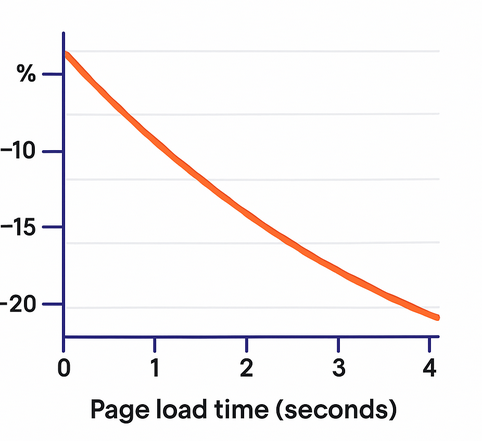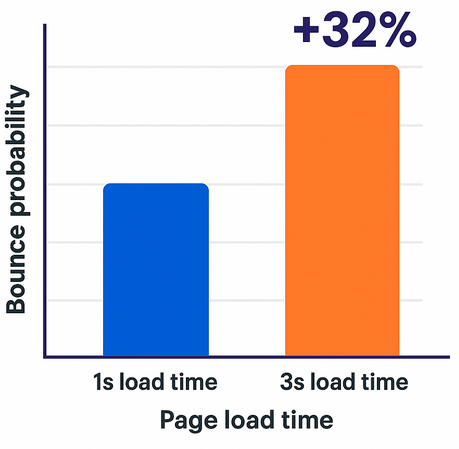Landing page performance directly influences user behavior and acquisition cost. When a page loads slowly, both paid and organic traffic lose efficiency.
Key performance truths:
-
A 1-second delay in page load can reduce conversions by up to 7%.
-
Bounce probability increases by 32% when load time grows from 1 to 3 seconds.
-
Mobile users expect pages to load in under 3 seconds, yet the average mobile page takes more than 5 seconds.

Conversion rate drops ~4.4% for each additional second of load time (0–5s)
Fast pages win because they keep users engaged, reduce friction, and lower the cost of acquiring each lead.
How Slow Speed Hurts Conversion
A slow landing page affects every metric in your funnel:
-
Higher bounce rate: Users leave before the content loads.
-
Lower conversion rate: Even engaged visitors convert less if the experience feels sluggish.
-
Higher CPA: Ads deliver clicks, but slow pages waste the traffic.
-
Weaker remarketing pools: If people don’t load the page, they can’t be added to your remarketing audiences.

Bounce probability jumps by 32% when load time increases from 1s to 3s
In performance marketing, every second costs money. Faster pages recover lost revenue instantly without requiring more ad spend.
Ideal Speed Benchmarks
Aim for the following performance thresholds:
-
Largest Contentful Paint (LCP): Under 2.5 seconds
-
First Input Delay (FID): Under 100 ms
-
Total Blocking Time (TBT): Under 300 ms
-
Total page load: Under 3 seconds on mobile
These benchmarks ensure a responsive, frictionless experience that supports higher conversion rates.
How to Cut Load Time Fast
Below are actionable improvements that deliver immediate speed gains.
1. Compress and Optimize Images
Images typically account for 50–70% of total page weight.
-
Convert to WebP or AVIF.
-
Serve responsive images based on device.
-
Compress without visible quality loss.
A 30–40% reduction in image size often translates directly into faster loading.
2. Reduce Scripts and Third-Party Code
Excess trackers, widgets, and chat plugins slow everything down.
-
Remove unused or redundant scripts.
-
Load non-essential scripts after the main content.
-
Combine and minify JS and CSS.
Pages with heavy script usage can see load times reduced by 20–40% after cleanup.
3. Implement Lazy Loading
Load only what users see first.
-
Lazy-load images below the fold.
-
Defer videos, carousels, and animations.
This keeps the initial load light, improving LCP.
4. Improve Server Response Time
Hosting and backend optimizations influence Time to First Byte (TTFB).
-
Use fast hosting or upgraded infrastructure.
-
Apply caching.
-
Minimize slow backend processes.
A TTFB under 200 ms significantly boosts total load speed.
5. Use Caching and CDNs
Static assets should be delivered instantly.
-
Cache pages on the server and browser.
-
Deliver assets via a global CDN.
CDNs can reduce latency by 30–50% for global users.
How Speed Affects Paid Campaign Performance
Fast landing pages increase the efficiency of every paid channel. When pages load faster:
-
CTR-to-conversion ratio improves.
-
Cost per click becomes more profitable.
-
Quality score (or relevance ranking) increases.
-
More visitors complete forms or add products to cart.
Based on industry data, pages loading in under 3 seconds achieve conversion rates 2x higher than pages taking 5 seconds or more.
Checklist: Fix Speed in 30 Minutes
Use the following quick workflow:
-
Compress heavy images.
-
Remove unnecessary plugins.
-
Turn on server caching.
-
Lazy-load below-the-fold content.
-
Defer non-critical scripts.
Even small improvements compound into higher revenue.
Additional Articles to Continue Learning
Here are three related articles to explore next:
Conclusion
Landing page speed is not a technical detail — it is a direct profit multiplier. Faster pages convert more visitors, improve paid performance, reduce acquisition costs, and create a smoother user experience. By focusing on speed optimization, brands unlock immediate increases in conversion without increasing ad spend.

